Lesson Plans & Sequential learning experiences
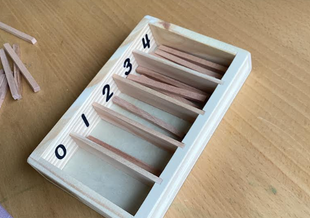
Lesson Plan
Date: 30/07/2025
Lesson plan created from observations of Counting with sticks – Number recognition
Starting point
Drawing on observation, assessment and evaluation data
Observations recorded for Child 1, Child 2, Child 3, Child 4, Child 5 and Child 8 for the counting with sticks mathematics game focusing on Number recognition. Please refer to my e-portfolio to see detailed individual child observations of the task that prompted additional learning experiences.
Goal: Is to explore Numeracy skills with the children, building on number recognition from numbers 1-10 . This will be done through games, role modelling techniques and child-led provocation.
1. From my initial observations on the children, Child 1 out of the 6 observed, was the only child able to fully achieve and comprehend the counting stick number recognition game. Child 2, 3, 4, 5 and 8 all had similar capabilities and struggled to recognise the numbers from 3 onwards and are in the emerging phase of their number recognition and counting skills. It was evident that all the children in observation would benefit from consistent exposure and opportunities to engage in mathematical learning, numeracy and number recognition. The children’s strengths was that they were able to continue attempting the task with role modelling techniques e.g: myself prompting for the next number and supporting their counting and repetition of number recognition.
2. The learning I want to extend is the children’s numeracy skills and number recognition of numbers 1-10. By planning supportive games, that encourage further use and identification of numbers. From observations some of the younger children will benefit from an adjusted experience that holds the interest and attention spans of Child 2, 4, 5 & 6 e.g: car park mathematics activity or 1-10 hopscotch. Where as 1-10 number bingo will meet the requirements and developmental stage of child 1, 3, 7 & 8.
3. Guided by the center’s philosophy I created two learning experiences that embed this. E.g: Inclusive environments that provide access, participation and engagement in learning for all children in our care. I supported this by planning an indoor and outdoor experience to cater to the unique needs and interests of the children. Following the centers educational program component that Teacher use the EYLF and QKLG frameworks to support teachers to plan and implement quality teaching and learning. Supporting the children to be involved in their own learning, supporting them to be capable and confident learners. By responding to their ideas and interests and guiding their learning through scaffolding and engagement. Settings that promote inquiry based leaning with rich engaging environments and meaningful interactions. My two learning experiences were created in collaboration and aligning with the centers philosophy.
4. My goal is to provide the children with a two sequential learning experiences, that extend and explore the children’s current capabilities and knowledge of numeracy. Facilitating a 1-10 number bingo game, that promotes the use of number recognition. Modifying the experiences for individual children’s development e.g; 11-20 number bingo for the children that are extending their number recognition (Child 1). But a 1-5 number bingo or a car park mathematics activity for the children that are emerging their number recognition skills (Child 2, 4, 5 & 6). 1-10 number bingo for the children that are exploring and meeting 1-10 number recognition. 1-10 outdoor chalk paint hopscotch for the children that prefer outdoor and play based experiences. Through these mathematical learning experiences, indoor and outdoor games I will draw on the children’s attention to symbols and patterns in their environments and talk about patterns and relationships, of numbers and number identification.
EYLF Outcome : Children are confident and involved learners
4.1: Children develop a growth mindset and learning dispositions such as curiosity, cooperation, confidence, creativity, commitment, enthusiasm, persistence, imagination and reflexivity
4.2: Children develop a range of learning and thinking skills and processes such as problem solving, inquiry, experimentation, hypothesising, researching and investigating
4.3: Children transfer and adapt what they have learned from one context to another
4.4: Children resource their own learning through connecting with people, place, technologies and natural and processed materials
EYLF : 5.4 Children begin to understand how symbols and pattern systems work.
· Children begin to be aware of the relationships between oral, written and visual representations.
· Children begin to recognize patterns and relationships and the connections between them.
QKLG: 5.3 Building numeracy in personally meaning ways.
· Children begin to make connections to mathematical concepts in everyday situations
· Children begin identifying similar features of objects to form small collections and practice counting to identify the number of objects in the collection
Rationale: Planning for the learning, why have you decided on this goal?
· The lesson plan goal reflects from evaluations through observations obtained of the focus children engaging in a counting stick game. The two learning experiences I have created to accentuate the overall goal of improving the children’s 1-10 number recognition capabilities. I decided on this goal, as the majority of my focus children are beginning school (Prep) in 6 months’ time. Through observation, 7 out of the 8 children found recognition and counting from numbers 1-10 quite challenging. This goal is important to provide the children with the necessary skills and support to enhance their knowledge of number recognition to display essential school readiness skills. ST suggested I use wording like collections of numbers and multimodal, as I’m using a variety of teaching strategies to promote number recognition.
Plan: With your goal and rationale in mind, plan a sequence of two learning experiences using the space, time, material and role of the teacher considerations
1. Learning experience 1: 1-10 Number bingo
Enhance the children’s prior knowledge through a 1-10 number bingo game. That strengthens the children’s knowledge of numbers and recognition of numbers through repetition and exposure to symbols and patterns.
Adjusted 1-5 number bingo or Car park mathematics provocation activity for the younger children or children still emerging their number recognition skills.
2. Learning experience 2: 1-10 Hopscotch
Facilitating an outdoor 1-10 hopscotch game that disguises the use of numbers. A game that improves number recognition and the use of counting without the children taking notice. The numbers 1-10 will be written in each square and I will use encouraging ques to encourage the use of recognition of numbers as the children engage in the hopscotch.

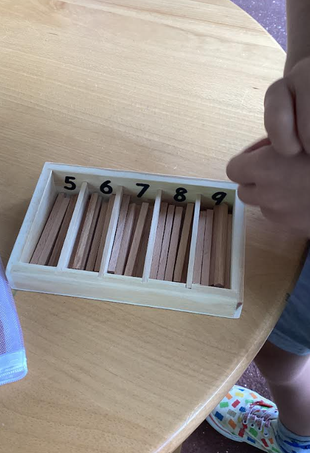
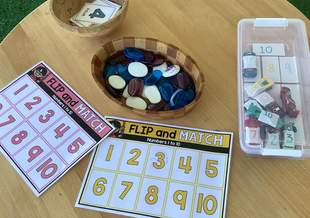
Learning Experience 1
Activity 1 – (1-10 Number Bingo or cark park mathematics activity)
Date: Tuesday 05/08/2025
Physical Space (the physical space)
· The 1-10 number bingo will be presented to a small group of children as a table top teacher led experience. This promotes children to take the lead, calling out each number and matching it to the corresponding number on their 1-10 bingo sheet. I will have 4-6 children play the game and sitting at the table experience at a time. Guiding children through the game and encouraging role modelling and assistance between the children to identify the number card shown each time.
Time
· This activity will be set up during morning learning and child-initiated play experiences time. Available on the table from 9:45-11:30am.
· Also during focus time, to encourage number recognition through number bingo during this quiet time.
Materials
· 6 Laminated 1-10 number bingo sheets. 1-10 number cards
· 4-6 white board markers and erasers
· Table and chairs
Role of the teacher
I will facilitate and set up the number bingo in the morning for children to view as they enter the kindy room. Myself and my supervising Teacher will explain the activities and play spaces and what’s on offer for the day. As the children free flow into spaces in the classroom for child led learning time, the children can choose to engage in a small group of 1-10 number bingo. Ask and role model the children into the game if they show interest. I will facilitate the experience by presenting the game as a small group table top numeracy game. As a teacher my pedological approach is grounded in constructivism, where the children actively construct knowledge through experience. The 1-10 bingo game provides a scaffolded environment where children engage with numbers. In this activity I position myself as a facilitator, guiding the children through the game whilst supporting their their exploration of numbers independently and collaboratively with the help of peers. I will observe the children’s current number recognition and interactions with numbers. Providing open-ended questions that encourage inquiry and extension of learning e.g: “What do you think this number is?” “This is the number that comes after 3”. My role will involve fostering a positive and inclusive classroom, where all children have the opportunity to engage in the experience and feel supported. The number bingo game is supported by the EYLF curriculum. Specifically, outcome 4: Children are confident and involved learners. This game promotes mathematical thinking by encouraging children to experiment with numbers in play-based concept. This play-based nature of number bingo also reflects a Reggio Emilia inspired approach, which highlights the importance of child-centered experimental learning e.g: the use of images and number cards. I tap into the children’s natural curiosity and creativity, fostering a love for mathematics.
APST 2.1: Content and teaching strategies of the teaching area: The number bingo game introduces number recognition (1-10) in a structured yet engaging way, I created an age-appropriate mathematics game, using colorful bingo cards and stones, calling out numbers and incorporating manipulated (the stones) to reinforce counting skills and number recognition.
APST 3.3: Use teaching strategies: Include a range of teaching strategies. I created differentiated teaching strategies throughout the implantation of the number bungo game to cater for children individual learning needs and requirements. For example, I might use the number cards for visual learners who excel from visualising the numbers. Whereas some children might benefit from auditory learning, for example, calling out a number for them to place a stone on or asking them to pick a number card and identify the number before and after the number is called, prompting classification skills.
Evaluation:
Reflecting on the 1-10 number bingo learning experience and the Implementation of the activity. The children showed involvement in their learning and towards the number bingo actvity. But some children became distracted and found it challenging to concentrate. The focus children that engaged in the number bingo were child 2, child 4, child 5 and 8. I found that the activity didn’t show much assistance towards the focus children’s number recognition. The children showed more engagement and enthusiasm for the number bingo, when I asked them open-ended questions like “Child 4, can you pick a number card to read out” or “What number is this?” “Who has number 8”. This involved a positive and inclusive environment, where all children were given opportunities to engage with numbers and collaborate with each other. Child 2 and 5 assisted child 8 to recognise and place counters on the corresponding number. As a result of the children becoming disengaged in the number bingo, I offered the 1-10 car park mathematics game, the children showed an excelling interest in this activity and seemed to grasp the concept faster. Child 5 being able to complete the whole game and match all numbers unassisted. Which he was unable to do in the counting stick game. Which led me to develop a sequential learning experience that involved play-based number exploration.
What next?
Based off my observations and assessment of children’s learning and interests from the 1-10 number bingo experience, I developed a sequential learning experience with a correlation from Jean Piaget’s theory. The theory presents that children in the the preoperational stage (ages 2 to 7): Children in this stage start to use symbols and language to represent objects and events. This is when symbolic play and drawings emerge (McArdle, 2023) From this I thought about creating a 1-10 hopscotch outdoor activity that instills number identification and involvement with numbers in a play-based notion. Piaget found that children learn by actively engaging with their environment, which is where the hopscotch will benefit the children’s number recognition by engaging with numbers in active learning experience which is ideal for cognitive development. (McArdle, 2023) My goal is for children to remain involved and participate in the hopscotch, showing confident and enthusiasm for their learning. Transferring what the children have learnt in one context to another.
· EYLF 4.1: Children develop a growth mindset and learning dispositions such as curiosity, cooperation, confidence, creativity, commitment, enthusiasm, persistence, imagination and reflexivity
· EYLF 4.3: Children transfer and adapt what they have learned from one context to another
· QKLG: 5.3 Building numeracy in personally meaning ways.
· APST 2.1 Content and teaching strategies of the teaching area: Demonstrate knowledge and understanding of the concepts, substance and structure of the content and teaching strategies of the teaching area
· APST 2.2 Content selection and organisation: Organise content into an effective learning and teaching sequence.
· APST 3.2 Plan, structure and sequence learning programs: Plan lesson sequences using knowledge of student learning, content and effective teaching strategies.
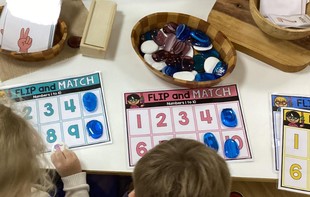
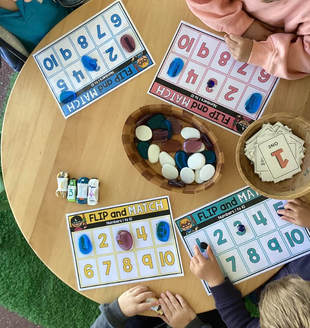
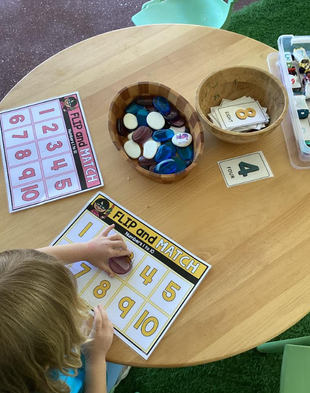
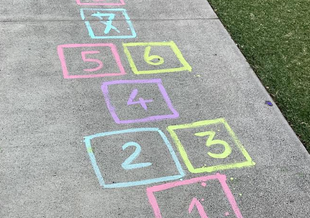
Learning Experience 2
Activity 2 – (1-10 Hopscotch game)
Date: Thursday 07/08/2025 & Friday 08/08/2025
Space (the physical space)
· Outdoor hopscotch game, to facilitate number recognition in an outdoor environment. The hopscotch will be painted on the concrete in the main play area in the outdoor play space. Gather children to assist with the planning process and painting of the numbers and hopscotch.
Time
· The hopscotch game will be created in collaboration during the morning with the children and painted in the main play area in the outdoor environment. The game will be available to children at any time they enter the yard for outdoor play. Usually between the times of 7:30am-9:00am and 2:30-4:30pm.
Materials
· Ingredients to make washable chalk paint. E.g: Corn flour, food colouring and water
· Paint brushes, paint holders
Role of the teacher
• I will create a hopscotch game, using chalk paints. I will work with a small group of children when painting the hopscotch on concrete and ask hypothetical questions that promote inquiry and involvement in the facilitation of the game. Observing which children know the number I will paint next, watch which children shows interest in the activity or begins counting and collaborating with peers predicating which number comes next. I will engage the children by involving them in the whole process from start to finish. For this experience I want the children to take the lead in their own learning. By taking a step back once the hopscotch is created, observing how the children use the game, whether they count as they jump, how they jump, whether they can hop on jump, if they can recognise the numbers. Through this I will use role modelling techniques to encourage the children to identify and verbally count each number as they jump and hop through the hopscotch. My pedagogical approach for the hopscotch game is rooted in socio-cultural theory, supporting children’s learning through social interactions and physical engagement. I will act as a co-learner, participating in the game to model number recognition and encourage enthusiasm and involvement in the game. By asking open-ended questions e.g: “What number are you standing on?” “What number comes next?” I scaffold children’s thinking and promote problem-solving. I will also observe and assess children’s number recognition and motor skills to plan for future learning. My approach to facilitating this experience was to ensure inclusiveness and diversity of learners, so that even children who don’t enjoy engaging in regular numeracy experiences in the classroom, can participate in this outdoor number hopscotch to build upon their current skills and mathematical abilities. The hopscotch game will be painted on the concrete so available for children throughout the week, easy for them to enter and exit play, add their own approach and create their own games stemming from the original hopscotch.
• APST 2.2 Link: Organise content into an effective learning and teaching sequence: The hopscotch game is structured to build upon number recognition progressively. Children hop on numbers in sequence (1-10) reinforcing their understanding of numerical order. I extend on the activity by asking children to name the numbers they hop or step onto e.g “Hop to number 7” or “What number did you land on” which deepens their understanding of number relationships.
Evaluation:
· The children showed enthusiasm and involvement for their learning through engaging in the hopscotch. The children helped to paint the hopscotch and predict which number would come next. By working alongside the children when implementing the hopscotch the children felt included in the development of the experience. The children asked “can I add the number 4?” and “what number comes next?” as we collaborated to create the hopscotch. As I painted on each number I would ask the two children what number comes next e.g: What number comes after 3?’ Child 2: “4 does”. 2 of the focus children added to the hopscotch, creating their own numbers and additional squares. Extending on the experience by identifying number and painting the numbers. Transferring and adapting what they have learnt from one contxext to another EYLF 4.3 and showing confidence and involvement in their learning. I believe my teaching strategies worked well in engaging the children and fostering child-led learning and inquiry. But I could have spent more time role modelling the hopscotch to the group of children. In reflection the implementation and creation if the hopscotch was more affective in exposure to number recognition than the hopscotch experience itself. Next time I would spend more time afterwards engaging the children with verbalising the numbers as they hop and jump in each square. Surprisingly the children enjoyed painting their own hopscotch and painting numbers themselves.
What next?
· To extend on this experience whilst continuing the learning cycle, I would base the next experience off my findings and observations from this experience. To further the children’s learnings, whilst supporting their interests, I would use number cards or number symbols for the children to paint their own numbers. This could be in the form of hopscotch or freehanded. For example, placing a laminated number title on the concrete and the children have the opportunity to paint the number below. Or a number scavenger hunt around the outdoor environment e.g: “can you find the number 7” even using a 1-10 reference sheet and they have to tick off each number they find. This would build upon the children’s current abilities and number recognition and provide the children with the opportunity to expand their inquiry of numbers, patterns and symbols further. Promoting problem solving and investigation of numbers engaging with numeracy in personally meaningful ways.
· EYLF 4.2: Children develop a range of learning and thinking skills and processes such as problem solving, inquiry, experimentation, hypothesising, researching and investigating
· EYLF 4.3: Children transfer and adapt what they have learned from one context to another
· QKLG: 5.3 Building numeracy in personally meaning ways.
· APST 2.1 Content and teaching strategies of the teaching area: Demonstrate knowledge and understanding of the concepts, substance and structure of the content and teaching strategies of the teaching area
· APST 2.2 Content selection and organisation: Organise content into an effective learning and teaching sequence.
· APST 3.2 Plan, structure and sequence learning programs: Plan lesson sequences using knowledge of student learning, content and effective teaching strategies.
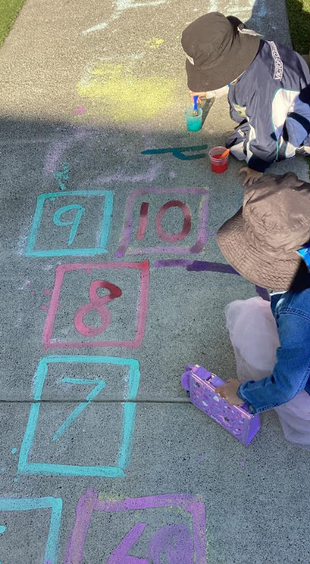
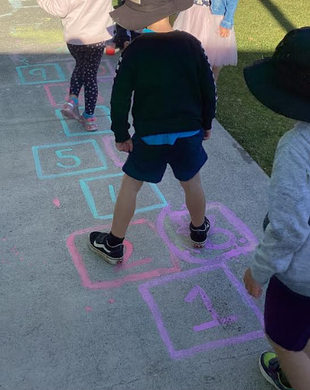
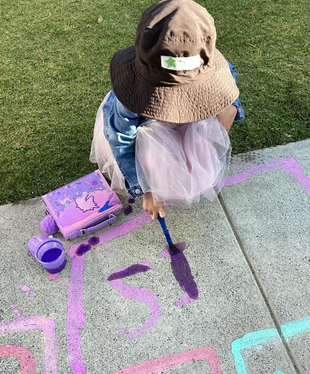
Create Your Own Website With Webador